Meltdown 101: Why is Fukushima crisis still out of control?
Loading...
| Washington
Emergency workers are still struggling to contain a crisis at a Japanese nuclear plant five days after an earthquake and tsunami pulverized Japan’s northeastern coast. Yet the reactors at the site shut down automatically when rocked by the quake March 11. Spent-fuel pools contain fuel rods removed from reactors months ago.
Why is it taking so long for all this fissile material at the Fukushima Daiichi complex to cool down?
The answer to that question is that, without artificial cooling, nuclear power-plant fuel remains “alive” enough to generate combustion-level amounts of heat and dangerous radioactivity for months on end. And at Fukushima, the earthquake and tsunami have knocked out these crucial artificial cooling systems.
Even if workers manage to restore core cooling systems to reactors and to get water levels back to normal in spent-fuel pools – a big “if” at this point – it will be some time before the situation is back under control, said David Lochbaum, director of the nuclear safety program at the Union of Concerned Scientists, in a conference call with reporters Tuesday.
“If they get those under control, they have about five days to a week before things get back to a stable level,” said Mr. Lochbaum.
The main problem: 'decay heat'
When reactors are shut down, the nuclear chain reaction which releases energy – and thus heat – from the uranium atoms of fuel shuts down as well. But the fuel continues to release smaller amounts of energy from the radioactive decay of fissile fragments.
This “decay heat” amounts to about 6 percent of the total heat generated by the reactor core when it is running, according to a fact sheet on nuclear energy physics from the World Nuclear Association, an industry trade group.
This decay heat falls off quite rapidly. After one hour, it will equal 1.5 percent of the previous core power, and so on. But the amount of energy generated by the core can be so enormous to begin with that even this residual heat can be dangerous. After one year offline, used fuel still emits about 10 kilowatts of decay heat energy per ton. After 10 years, it emits 1 kW of heat per ton.
“The decay heat produced is significant ... and systems must be provided to keep the reactor cool even after shutdown,” says a US Department of Energy handbook on nuclear physics.
Another problem: zirconium 'cladding'
It is not known how much nuclear material at the Fukushima plant is giving off decay heat, but those cooling systems have broken down in the wake of Japan’s natural disaster. Pumps have failed, exposing fuel rods in reactor cores to air for some period of time, causing damage yet unknown. Heat has caused water in spent-fuel pools to boil away, necessitating heroic attempts to try and spray or dump more water on the spent-fuel rods.
Adding to the problem, the zirconium alloy covering or "cladding" for the uranium pellets – which forms the fuel rods – oxidizes rapidly in the presence of air, heat, and steam, according to Arjun Makhijani, a nuclear expert and president of the Institute for Energy and Environmental Research.
This reaction itself releases large amounts of heat, adding to a situation where heat is already the primary enemy. The result of this oxidization can be a self-sustaining reaction, or zirconium cladding fire, that burns along the fuel rod, as a child’s sparkler burns up its length.
On Wednesday the International Atomic Energy Agency reported that Japanese authorities have “reported concerns” about the conditions of the spent-fuel pools at units 3 and 4 of the Fukushima Daiichi plant.





